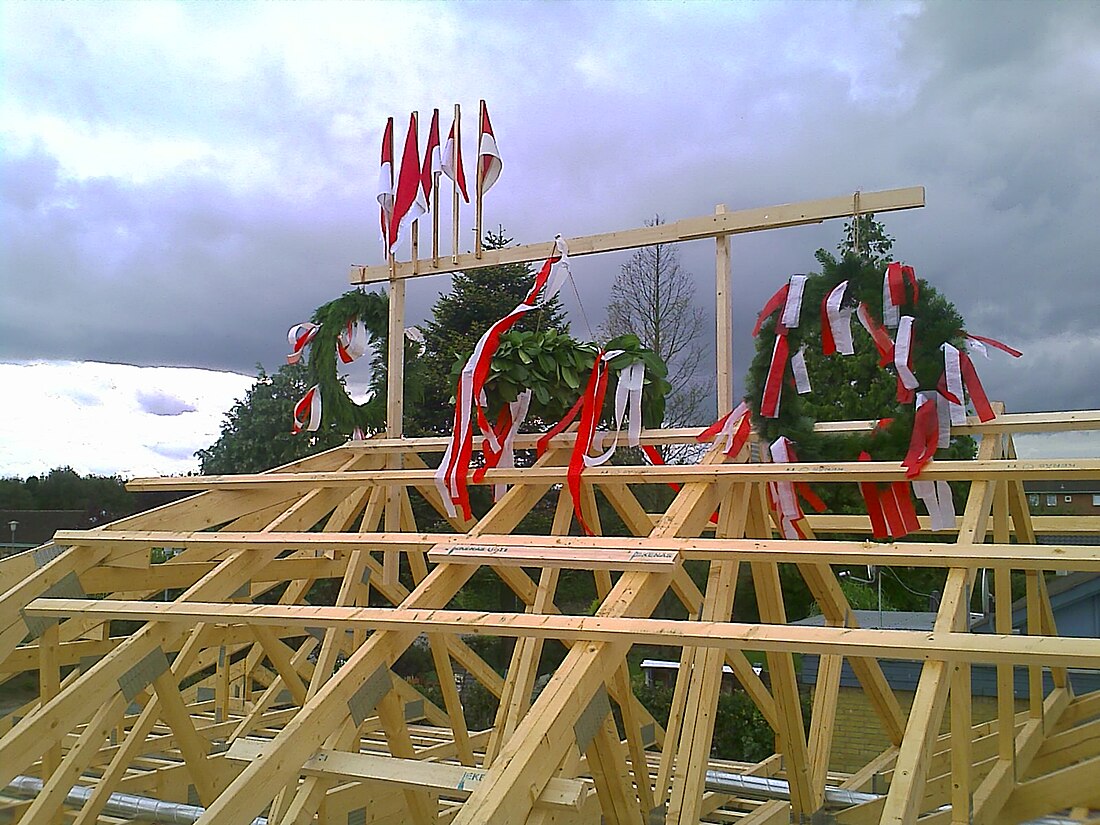Top Qs
Timeline
Chat
Perspective
Topping out
Builders' rite when the last beam (or equivalent) is placed From Wikipedia, the free encyclopedia
Remove ads
In building construction, topping out (also referred to as topping off or roofing ceremony) is a builders' rite traditionally held when the last beam (or its equivalent) is placed at the top of a structure during its construction. Nowadays, the ceremony is often parlayed into a media event for public relations purposes.[1] It has since come to mean more generally finishing the structure of the building, whether there is a ceremony or not. It is also commonly used to determine the amount of wind on the top of the structure.

A Scandinavian tradition of hoisting a pine tree to the top of framed out buildings had a more functional purpose: when the pine needles fell off, the builders knew the wood frame below had cured/dried out so they could enclose the building.[2]
Remove ads
History
Summarize
Perspective
The practice of "topping out" a new building can be traced to the ancient Scandinavian religious rite of placing a tree atop a new building to appease the tree-dwelling spirits displaced in its construction. [3] The tradition also served a functional purpose: a pine tree was used, and after the needles had fallen off the tree, the builders knew the wood frame below had cured/dried out so they could enclose the building.[4] Long an important component of timber frame building,[5] it migrated initially to England and Northern Europe, then to the Americas.
A tree or leafy branch is placed on the topmost wood or iron beam, often with flags and streamers tied to it. A toast is usually drunk and sometimes workers are treated to a meal. In religious context, it is a nod to the completion of construction for Noah’s Ark. In masonry construction the rite celebrates the bedding of the last block or brick.[citation needed]
In some cases a topping out event is held at an intermediate point, such as when the roof is dried-in, which means the roof can provide at least semi-permanent protection from the elements.[6]
The practice remains common in the United Kingdom and assorted Commonwealth countries such as Australia[7] and Canada,[8] as well as Germany, Austria, Slovenia, Iceland, Chile, Czech Republic, Slovakia, Poland, Hungary and the Baltic States. In the United States the last beam of a skyscraper is often painted white and signed by all the workers involved.[7] In New Zealand, completion of the roof to a water-proof state is celebrated through a "roof shout", where workers are treated to cake and beer.[9]
The tradition of "pannenbier" (literally "(roof) tile beer" in Dutch) is popular in the Netherlands and Flanders, where a national, regional or city flag is hung once the highest point of a building is reached. It stays in place until the building's owner provides free beer to the workers, after which it is lowered.[10] Since the workers are treated to free beer as long as the flag is raised, the workers are considered greedy if they fly the flag for more than a few days.[citation needed]
Remove ads
Gallery
- Topping out (wiecha) in Poland
- The final section of the Warsaw radio mast (in foreground) is decorated and ready to raise
- Topping out in Norway (1959)
- Topping out of Xibeiwang MIXC in Beijing, China with celebration banners (2021)
- Topping out of the National Library of Latvia
See also
Notes
References
External links
Wikiwand - on
Seamless Wikipedia browsing. On steroids.
Remove ads





